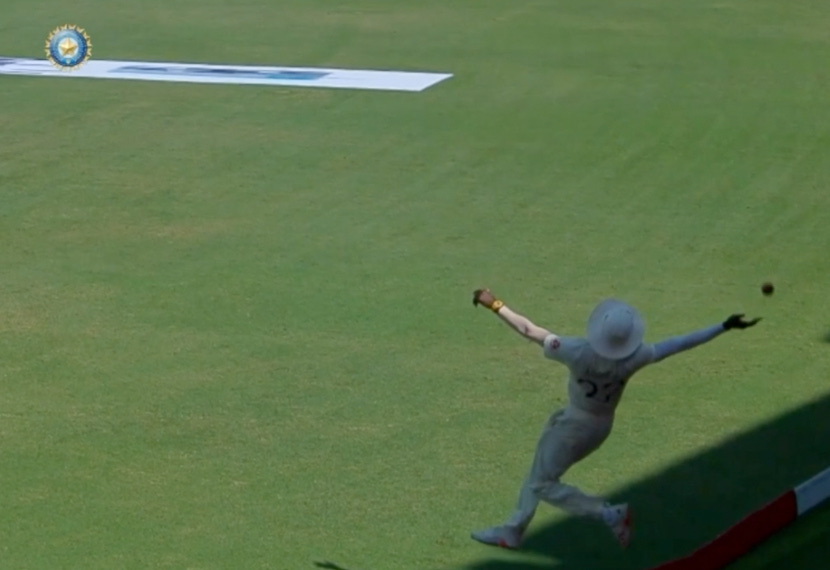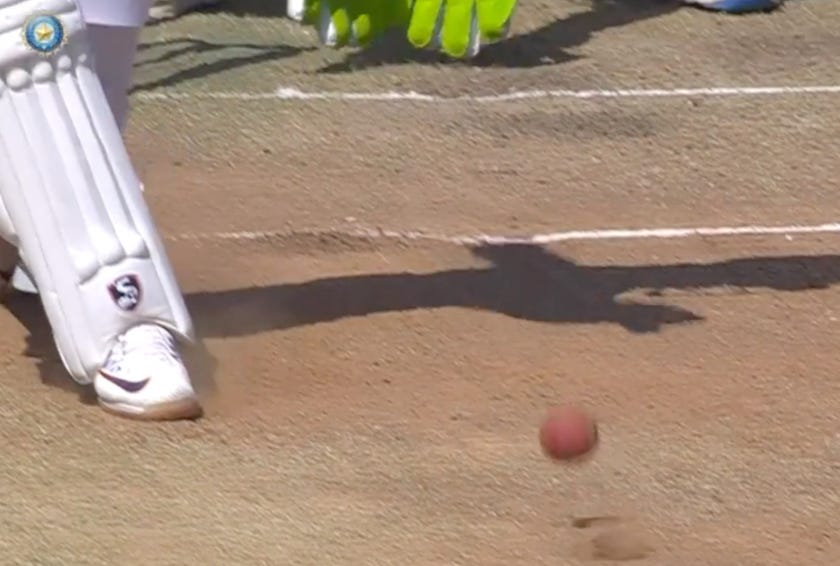Long on is a defensive position. It appears in a Test match because someone is going hard against a spinner, or there is some end of innings slogging.
Older cricket players and fans hate when spinners start with a long on. The same way they hate seam bowlers having a sweeper out. They believe the batsman should earn it by stepping down the wicket and lofting the ball to the boundary. And in Tests, that used to be seen as a risky shot. First leaving the crease where your specialist wicketkeeper would be behind the wicket waiting to pounce on your mistake. Then you had to clear mid-on, a mis-hit could get you caught, and so would hitting hard but low.
So a few things have changed, the wicketkeepers aren't as good now, Jos Buttler has three first class stumpings in 63 matches. Rishabh Pant missed a clear-sighted chance in this match. Then there is the mid-on. If you swing hard, the only way mid-on will catch you is if you cannot loft the ball right, or hit it straight up in the air. Most normal miss-hits will float well clear of mid-on. And it's not just the big bats, but the way batsmen swing now. This isn't a high elbow punch through the line, these are full swings, often power hits, and not always traditional cricket shots. And players have been in the gym to get strong for this. They range hit for T20, and are used to seeing their balls going into the stands.
Modern cricket is about the ball being in the air.
The reason spinners have the long-on at the start is that they think batsmen will still hit. Long on is not a deterrent to many modern batsmen. Many see as not that much different than mid-on, just a player to be cleared.
Through the era of Kevin Pietersen, Chris Gayle, Brendon McCullum and Virender Sehwag we saw this change. Batsmen were willing to be caught by deep fielders, in a way outside hook shots that hadn't been common since cricket's more amateur days.
Now more players have that mindset, spinners don't see long on as a defensive option, they see it as a catching position.
Look at today, the first ball that Jack Leach bowled to Rishabh Pant, he had a long on in, and yet Pant came down the wicket to smash the ball over his head. And he mis-hit the ball, it would have gone over mid on's head, and did actually fall short of long on. It didn't matter where the fielders were because Pant wasn't trying to keep the ball inside the playing arena.
And Leach isn't some terrible bowler, he has averaged 30 with the ball in Tests over his first 12 matches. That is a really excellent record for a spinner from outside of Asia. If England only picked him when he has to go up against right-handers or on turning tracks, he could have a wonderful career as a second spinner.
Pant had never faced him, had only seen 11 balls in the innings so far, not one from Leach, and tried to hit him for six over a man on the boundary. The third ball he faced he danced down again. As the ball was straighter, he dragged it to mid-wicket for six. So England put out a deep mid-wicket, and he hit the next one there too.
And he was nearly out, so obviously you would change your game, except no, next over he went back to long-on. The following over he goes over long on again, because of course he did, this time he was almost caught for a second time, but gets away with it. He'll do one more later as well. Five sixes from Leach, four of them were directly over the head of the boundary rider.
But it wasn't just that, it was also from, or near the footmarks. You can see on more than one occasion when the ball landed that puffs of dust pop up.
Traditionally batsmen try not to hit out of the footmarks, because seamers have big heavy feet, and they ruin the flatness of the pitch. And that is partly why Pant was batting as he was. He thought he could take Leach out of the attack completely, perhaps before one hit a pebble and rolled along the ground and bowled him.
It should also be pointed out that in T20 cricket Pant scores at 10 runs an over from left-arm finger spin. Sure, this is a different format, but Pant likes this breed of bowling. That is part of the reason he was confident enough to run down. Even when he didn't get to the pitch, just smack the ball that was spinning in a long way.
Many young batsmen come into Test cricket with a lot of shots. The constant disappointment of being dismissed while the media and fans dissect your every flaw often leads to players reigning themselves in. The exciting shots disappear, and they become professional grinders. Pant's batting may change like this, but this isn't just a young guy trying to whack the ball everywhere.
With Pujara scoring freely from Leach, and even Sundar trying to smash him, you would say India decided this was their best plan against him. But there was also a plan in this from Pant.
There is real thinking on this, he wasn't running down like a mad man, he was attacking when he saw the ball he wanted. And then committed. He is looking at the pitch, the type of bowler, the flight of each delivery, and the situation of the game while trying to shift the pressure back onto England. And he did. Not only did he top score, but he has already made England question Leach. And for the longest time, England thought he couldn't keep doing it. But, against Leach, he did.
Eventually, Pant would be out caught at deep cover going at Dom Bess out of the footmarks.
Pant was attacking out of a cabbage patch with two men on the boundary exactly where he was going to hit it, using all his white ball skills while his team was seven million runs behind. Cricket is not like it used to be. Long on is an attacking position.






